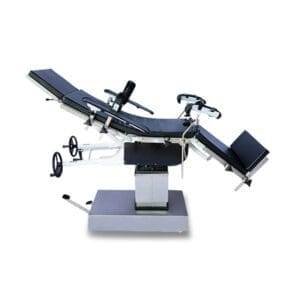Адрес
304 North Cardinal St.
Дорчестер-центр, Массачусетс 02124
Часы работы
С понедельника по пятницу: с 7:00 до 19:00.
Выходные: 10.00 - 17.00
In the fast-paced world of healthcare, where precision and patient safety are paramount, Manual Operating Tables (OT tables) play a crucial role. These tables serve as the foundation for various surgical procedures, offering stability and flexibility for both patients and medical teams. However, the safe and efficient use of manual OT tables requires adherence to specific safety measures. In this comprehensive guide, we explore the essential safety protocols and precautions that should be followed when using manual OT tables, ensuring the well-being of patients and the success of surgical interventions.
 Surgery is a highly precise discipline that demands meticulous attention to detail and patient safety. Manual OT tables, as crucial components of the surgical environment, require strict adherence to safety measures to ensure the well-being of patients and the effectiveness of procedures. This article explores the critical safety considerations that should be followed when using manual OT tables.
Surgery is a highly precise discipline that demands meticulous attention to detail and patient safety. Manual OT tables, as crucial components of the surgical environment, require strict adherence to safety measures to ensure the well-being of patients and the effectiveness of procedures. This article explores the critical safety considerations that should be followed when using manual OT tables.
Safety in surgery is paramount to protect the well-being of patients. Any lapses or oversights during surgical procedures can result in adverse outcomes for patients.
Safety measures contribute to the precision and success of surgical interventions. Proper positioning and stability are essential for surgeons to perform their tasks accurately.
Before placing a patient on a manual OT table, it is imperative to verify that the patient’s weight falls within the table’s specified weight limit. Exceeding this limit can compromise the table’s stability and safety.
Ensure that the patient is positioned correctly on the table, with all limbs securely placed to prevent unintentional movement during the procedure. Utilize safety straps and restraints as necessary, following manufacturer guidelines.
Before surgery begins, conduct a thorough check of the manual OT table’s stability. Ensure that all locking mechanisms are engaged, and the table is level. Any wobbling or instability should be addressed before the procedure starts.
During surgery, it is essential to maintain a sterile environment. Cover the OT table with sterile drapes and ensure that all instruments and surgical team members adhere to sterile protocols to prevent infections.
Surgeons must have precise control over the positioning of the manual OT table during the procedure. Make gradual adjustments to avoid sudden movements that could endanger the patient or disrupt the surgical field.
Effective communication within the surgical team is crucial. The surgeon should clearly communicate their positioning requirements, and team members should be prepared to make adjustments as needed.
When the surgical procedure is complete, exercise caution when transferring the patient from the OT table to a stretcher or recovery bed. Ensure that all restraints are removed safely, and the patient is moved gently to avoid injury.
After each surgery, the manual OT table should be thoroughly cleaned and disinfected according to hospital protocols. Regular maintenance, including inspection of moving parts and lubrication, should be performed to ensure ongoing safety and functionality.
Accurate documentation of the patient’s positioning, any adjustments made to the table during surgery, and postoperative actions taken is essential for record-keeping and quality control.
 Pediatric Patients
Pediatric PatientsWhen working with pediatric patients, additional safety measures are required due to their smaller size and unique physiological considerations. Ensure that the table and restraints are appropriately adjusted for pediatric patients to prevent accidental injuries.
Bariatric surgeries involve patients with higher weight requirements. Manual OT tables used for bariatric procedures must have the necessary weight capacity and stability. It is also crucial to have an adequate number of trained staff members to assist with patient positioning and transfers.
All members of the surgical team, including surgeons, nurses, and technicians, should receive training on the safe use of manual OT tables. This training should cover proper patient positioning, table adjustments, and emergency procedures in case of unexpected events.
Yes, manual OT tables can be used for bariatric surgeries, but they must have the appropriate weight capacity and stability to safely support bariatric patients.
If a patient’s weight exceeds the table’s capacity, an alternative table with a higher weight limit should be used to ensure safety and stability during the procedure.
Yes, there are specific safety guidelines for pediatric patients, including the proper adjustment of the table and restraints to accommodate their smaller size and unique needs.
Manual OT tables should be inspected for safety regularly, ideally before every surgical procedure. Routine maintenance checks should also be performed according to the manufacturer’s recommendations.
The surgical team plays a crucial role in ensuring OT стол safety by communicating effectively, following safety protocols, and making necessary adjustments during surgery to maintain patient positioning and stability. Team members should also be prepared to respond to emergencies promptly.
